Lane
In road transport, a lane is part of a carriageway that is designated to be used by a single line of vehicles to control and guide drivers and reduce traffic conflicts.[1] Most public roads (highways) have at least two lanes, one for traffic in each direction, separated by lane markings. On multilane roadways and busier two-lane roads, lanes are designated with road surface markings. Major highways often have two multi-lane roadways separated by a median.

Some roads and bridges that carry very low volumes of traffic are less than 4.6 metres (15 ft) wide, and are only a single lane wide. Vehicles travelling in opposite directions must slow or stop to pass each other. In rural areas, these are often called country lanes. In urban areas, alleys are often only one lane wide. Urban and suburban one lane roads are often designated for one-way traffic.
History
For much of human history, roads did not need lane markings because most people walked or rode horses at relatively slow speeds. However, when automobiles, trucks, and buses came into widespread use during the first two decades of the 20th century, head-on collisions became more common.
The history of lane markings is connected to early mass automobile construction in Detroit. In 1906, the first Road Commission of Wayne County, Michigan was formed in an effort to make roads safer. (Henry Ford served on the board in the first year.)[2] In 1909, the commission ordered the construction of the first concrete road (Woodard Avenue in Detroit), and conceived the centerline for highways in 1911. Hence, then chairman of the Road Commission, Edward N. Hines, is widely credited as the inventor of lane markings.[3]
The introduction of lane markings as a common standard is connected to June McCarroll, a physician in Indio, California. She began experimenting with painting lines on roads in 1917 after being run off a highway by a truck driver. After years of lobbying by Dr. McCarroll and her allies, the state of California officially adopted a policy of painting lines on its highways in November of 1924. A portion of Interstate 10 near Indio has been named the Dr. June McCarroll Memorial Freeway in her honor.
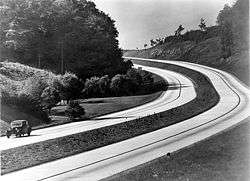
The first lane markings in Europe were painted at an accident hotspot in the small town of Sutton Coldfield near Birmingham, England in 1921. The success of this experiment made its way to other hotspots and led to standardization of white paint lane markings throughout Great Britain.[4]
The first use in Germany was in Berlin in 1925, where white paint marked both lanes and road edges. When the standard for the new autobahn network was conceived in the 1930s, it mandated the usage of black paint for the center line for each carriageway. Black is more visible on the bright surface of concrete.
By 1939, lane markings had become so popular that they were officially standardized throughout the United States. The concept of lane markings spread throughout the world and became standard for most roads. Originally, lines were drawn manually with ordinary paint which faded quickly. After World War II, the first machines for line markings were invented.[5] Plastic strips became standard in the 1950s. This gradually led to the placement of plastic lane markings on all major roads.
Types

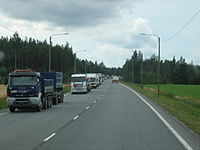
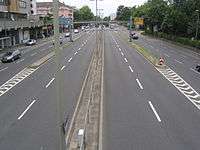
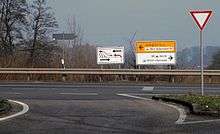
- A traffic lane or travel lane is a lane for the movement of vehicles travelling from one destination to another, not including shoulders.
_Aston_Expressway.jpg) The A38(M) Aston Expressway, showing tidal flow/reversible lanes controlled via overhead gantries, in Aston, Birmingham, England. This motorway has seven lanes, with the one lane always kept as a buffer in the centre - in the morning peak time, there are 2 lanes leaving central Birmingham (northbound) and 4 lanes in (southbound). In the evening, there are 4 lanes leaving central Birmingham and 2 lanes coming inwards. At all other times there are three lanes on each side.
The A38(M) Aston Expressway, showing tidal flow/reversible lanes controlled via overhead gantries, in Aston, Birmingham, England. This motorway has seven lanes, with the one lane always kept as a buffer in the centre - in the morning peak time, there are 2 lanes leaving central Birmingham (northbound) and 4 lanes in (southbound). In the evening, there are 4 lanes leaving central Birmingham and 2 lanes coming inwards. At all other times there are three lanes on each side. - A through lane or thru lane is a traffic lane for through traffic. At intersections, these may be indicated by arrows on the pavement pointing straight ahead.
- An express lane of a road is used for faster moving traffic and has less access to exits/off ramps. In other areas, an express lane may refer to a HOV lane (see below).
- A reversible lane (contraflow lane) is a lane where the direction of traffic can be changed to match the peak flow. They are used to accommodate periods of high traffic flow, especially rush hour where the flow is predominantly in one direction, on roads that cannot be easily widened such as over bridges. One or more lanes are removed from the opposing flow and added to the peak flow - this technique is known as tidal flow.
- An auxiliary lane is a lane other than a through lane, used to separate entering, exiting or turning traffic from the through traffic.
- An acceleration lane or merge lane allows traffic entering a highway to accelerate to the speed of through traffic before merging with it.
- A deceleration lane is a lane adjacent to the primary road or street used to improve traffic safety by allowing drivers to pull out of the through lane and decelerate safely before turning off a surface street or exiting a highway or motorway.
- A turn lane is set aside for slowing down and making a turn, so as not to disrupt traffic. By removing turning traffic from the through lanes, motorist safety is improved and delay is removed, but crossing distances for pedestrians are lengthened, increasing their exposure to collisions.
- A two-way centre turn lane is a lane in the centre of a roadway to allow drivers travelling in either direction to pause before turning across oncoming traffic (a left turn in right-driving countries, or a right turn in left-driving countries) while waiting for a gap in traffic.
- A passing lane is sometimes provided on busy two-lane roads to allow drivers to pass slower vehicles without having to cross the centre line and risking a head-on collision.
- A crawler lane, truck lane, or climbing lane is often provided on steep hill or mountain grades, in order to allow smaller vehicles to pass larger, slower ones. The lane is marked only on the uphill stretch and usually a short distance afterward (for regaining speed).
- An operational lane or auxiliary lane is an extra lane on the entire length of highway between interchanges, giving drivers more time to merge in or out. The lane is created when an entrance ramp meets the highway, and drops out (with an "exit only" sign) to become the ramp at the next exit.[6]
- A transfer lane of a road is used to move from express lanes to collector lanes, or vice versa; it is somewhat similar to an auxiliary lane.
- A collector lane of a road is used for slower moving traffic and has more access to exits/off ramps.
- Dedicated lanes are traffic lanes set aside for particular types of vehicles.
- A high occupancy vehicle, 2+ lane or carpool lane is reserved for carpooling. In the UK, such lanes are not extremely common, although they do exist in many places—they are usually marked "2+ LANE", referring to the fact that cars with two or more occupants may drive in the lane. In the US, they may be marked with a diamond icon every few hundred feet (hence the nickname "diamond lane"), or separated from other lanes by double broken white lines, a continuous pair of double yellow lines, or just a single broken white line.
- A high-occupancy toll lane is a combination of an HOV lane and toll collection technology that allows drivers without passengers to use the HOV lane by paying a premium price for the privilege
- A designated bicycle lane is a portion of the roadway or shoulder designated for the exclusive or preferential use of bicyclists. This designation is indicated by special word or symbol markings on the pavement and "BIKE LANE" signs.
- A motorcycle lane is provided at certain roads and highways such as the Federal Highway in Malaysia to segregate the motorcycle traffic from the main roadways to reduce motorcycle-related accidents. The motorcycle lane may form a part of the hard shoulder, or may be one or more completely separated lanes.
- A bus lane is reserved for buses providing public transportation on a fixed route, sometimes with overhead catenary for trolleybuses. In some countries, such as the in UK when signposted, bus lanes may also be used by some other traffic, such as taxis, bicycles and motorbikes.
- A tram lane is a lane reserved for the use of buses, trams and taxicabs. It is usually encountered in cities with curbside tram network, such as Zagreb.
- A truckway is a dedicated lane for longer length trucks; for instance, the Florida Turnpike allows 96-foot long double trailer combinations,[7] in contrast to normal Florida highways' 53-foot limit. Compare to crawler lane above.[8] Since the major cost of trucking is the fixed cost of the same trailer with its driver the cost per ton of operating with truckway size and weight allowances is 35 to 40 percent below the cost of operations on the non-truckways.[9]
- In some areas, the lane adjacent to the curb is reserved for non-moving vehicles.
- A parking lane is reserved for parallel parking of vehicles.
- A fire lane is the area next to a curb, which is reserved for firefighting equipment, ambulances, or other emergency vehicles. Parking in these areas, often marked by red lines, usually warrants a parking ticket.
- A loading lane (loading zone in the United States) is an area next to a curb, which is reserved for loading and unloading passengers or freight. It may be marked by a sign ("LOADING ONLY" or "LOADING ZONE") or by a yellow or white-painted curb.
- A hard shoulder is sometimes called an emergency lane or a breakdown lane, when it is reserved for vehicle breakdowns, and for emergency vehicles. On some congested roads, the shoulder is used as a vehicle lane during peak travel hours.
- By law or custom, outside (British usage of the word) lanes are often reserved for faster traffic, and inside lanes are used by slower traffic.
- An overtaking lane is the lane furthest from the shoulder of a multi-lane carriageway/roadway (sometimes called the fast lane, although this is deprecated by the authorities), i.e. the leftmost lane where traffic drives on the right, or the rightmost lane where traffic drives in the left.
- The slow lane is the lane nearest to the shoulder of a multi-lane carriageway/roadway, i.e. the farthest from the overtaking lane.
- These usages lead to the phrases life in the slow lane and life in the fast lane, used to describe relaxed or busy lifestyles, respectively and used as the titles of various books and songs.
Lane width

The widths of vehicle lanes typically vary from 2.7 to 4.6 m (9 to 15 ft). Lane widths are commonly narrower on low volume roads and wider on higher volume roads. The lane width depends on the assumed maximum vehicle width, with an additional space to allow for lateral motion of the vehicle.
In the United States, maximum truck width had been 96 in (2,400 mm) in the Code of Federal Regulations of 1956, which exactly matched then standard shipping container width of 8 feet (2,400 mm). Maximum truck width was increased in 1976 to 102 in (2,591 mm) to harmonize with the slightly larger metric 2.6 m (100 in) world standard width.[10] The same applies to standards in Europe, which increased the allowable width of road vehicles to a current maximum of 2.55 m (100 in) for most trucks, and 2.6 m (100 in) for refrigerator trucks. These widths does not include side mirrors, but only the vehicle body. The minimum extra space had been 0.20 m (7.9 in) and it is currently assumed to be at least 0.25 m (9.8 in) on each side. The international standard allows roads with less traffic to add a second or third lower width lane in the same direction for cars 1.75 m (69 in) - those that have been built exclude trucks from these narrower lanes; however lower width lanes are not a recommended design principle for new roads, as this could be risky if traffic becomes heavier in future.
In the United States, the Interstate Highway standards for the Interstate Highway System use a 12 ft (3.7 m) standard lane width, while narrower lanes are used on lower classification roads. In Europe, laws and road widths vary by country; the minimum widths of lanes are generally between 2.5 to 3.25 m (98 to 128 in).[11] The federal Bundesstraße interurban network in Germany defines a minimum of 3.5 m (140 in) for each lane for the smallest two lane roads, with an additional 0.25 m (9.8 in) on the outer sides and shoulders being at least 1.5 m (59 in) on each side. A modern Autobahn divided highway with two lanes per direction has lanes 3.75 m (148 in) wide with an additional clearance of 0.50 m (20 in) on each side; with three lanes per direction this becomes 3.75 m (148 in) for the rightmost lane and 3.5 m (140 in) for the other lanes. Urban access roads and roads in low-density areas may have lanes as narrow as 2.50 m (98 in) in width per lane, occasionally with shoulders roughly 1 m (39 in) wide.[12]
Extra lane width in horizontal curves
Depending on speed, road curvature and vehicle properties, heavy goods vehicle (HGV) combinations exhibit a phenomenon called 'high speed outside offtracking'. This means that the rearmost axle of the trailer does not follow the lateral path of the truck tractor unit, but may travel significantly—up to 1–3 meters (3–10 ft)—away from the curve center. Hence, narrow lanes on sharp curves have to be designed slightly wider than on straight road. The phenomenon is much larger on slippery snow-covered roads than on bare asphalt or cement concrete, calling for even larger lane widening.
Effects of lane width
In general, wider lanes are associated with a reduction in crashes,[13] but in urban settings both narrow (less than 2.8 m) and wide (over 3.1~3.2 m) lanes increase crash risks.[14] Wider lanes (over 3.3~3.4m) are associated with 33% higher impact speeds, as well as higher crash rates. Carrying capacity is also maximal at a width of 3 to 3.1 metres (9.8 to 10.2 ft), both for motor traffic and for bicycles. Pedestrian volume declines as lanes widen, and intersections with narrower lanes provide the highest capacity for bicycles.[14] As lane width decreases, traffic speed diminishes.[15] Some new urbanists argue that safety and capacity are not adversely impacted by reducing lanes widths to as little as 10 ft (3.0 m).[16]
Lane markings
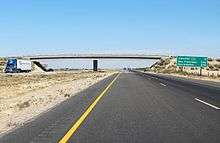
Painted lane markings vary widely from country to country. In the United States, Canada, Mexico, Honduras, Puerto Rico, Virgin Islands and Norway, yellow lines separate traffic going opposite directions and white separates lanes of traffic traveling the same direction, but such is not the case in many European countries.
Lane markings are mostly lines painted on the road by a road marking machine, which can adjust the marking widths according to the lane type.[17]
Lane numbering
Traffic reports in California often refer to accidents being "in the number X lane." The California Department of Transportation (Caltrans) assigns the numbers from left to right.[18] The far left passing lane is the number 1 lane. The number of the slow lane (closest to freeway onramps/offramps) depends on the total number of lanes, and could be anywhere from 2 to 8.
Capacity
Lane capacity varies widely due to conditions such as neighboring lanes, lane width, elements next to the road, number of driveways, presence of parking, speed limits, number of heavy vehicles and so on – the range can be as low as 1000 passenger cars / hour to as high as 4800 passenger cars / hour but mostly falls between 1500 and 2400 passenger cars / hour.[19]
See also
References
- "Lane – Definition and More from the Free Merriam-Webster Dictionary". merriam-webster.com. Archived from the original on February 4, 2015.
- "Home - Public Services". www.waynecounty.com. Archived from the original on April 14, 2015. Retrieved May 5, 2018.
- "MDOT - Hines, Edward N. (1870-1938)". www.michigan.gov. Archived from the original on June 30, 2015. Retrieved May 5, 2018.
- Douglas V. Jones: The Royal Town of Sutton Coldfield – A Commemorative History, Westwood Press 1994, ISBN 0-9502636-7-2.
- Zeitreise der Markierungstechnik
- "Glossary". Kurumi.com. Archived from the original on April 24, 2013. Retrieved June 3, 2013.
- "Rule 14–61 Tandem Trailers on Florida's Turnpike". www.floridasturnpike.com. Archived from the original on November 5, 2012. Retrieved January 2, 2016.
- "The 2015 Florida Statutes, 316.515(3)(b)2". www.leg.state.fl.us. Archived from the original on December 10, 2015. Retrieved January 2, 2016.
- Samuel, Peter. "The Way Forward to the Private Provision of Public Roads". Street Smart: Competition, Entrepreneurship and the Future of Roads. pp. 516–517.
- "Federal Size Regulations for Commercial Motor Vehicles". Archived from the original on September 18, 2015. Retrieved September 14, 2015.
- "EuroTest". Eurotestmobility.net. Archived from the original on March 11, 2012. Retrieved August 8, 2012.
- de:Richtlinien für die Anlage von Straßen – Querschnitt
- "Evaluating the Need for Surface Treatments to Reduce Crash Frequency on Horizontal Curves". Texas A&M Transportation Institute. Archived from the original on March 8, 2017. Retrieved March 7, 2017.
- Dewan Masud Karim. Narrower Lanes, Safer Streets (Accepted Paper for CITE Conference Regina, June 2015) "Archived copy". Archived from the original on September 23, 2016. Retrieved January 1, 2016.CS1 maint: archived copy as title (link) accessed January 1, 2015
- "Lane Width". Chapter 3: The 13 Controlling Criteria. US Department of Transportation Federal Highway Administration. Archived from the original on May 13, 2013. Retrieved June 3, 2013.
- "Theo Petrisch, "The Truth about Lane Widths," The Pedestrian and Bicycle Information Center, accessed April 12, 2013". Archived from the original on April 5, 2017.
- "how to paint road marking lines of different widths". Archived from the original on September 11, 2014.
- "Highway Design Manual: Chapter 60: Nomenclature" (PDF). California Department of Transportation. State of California. Archived (PDF) from the original on March 24, 2012. Retrieved June 3, 2013.
- Guide to Traffic Management Part 3: Traffic Studies and Analysis. Austroads. 2013. pp. Section 4.